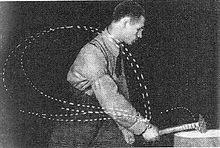Nikolai Bernstein

Nikolai Aleksandrovich Bernstein (
Life
Nikolai Bernstein graduated high school in 1913. He was interested in languages and philosophy and wanted to be a linguist so he enrolled at Moscow University to study History and Philology. However, as World War I broke out in the summer of 1914, the Bernstein family felt the need to help their country during these hard times. Nikolai then took an alternative route in his education and started attending the medical college where he graduated in 1919 with a medical degree. Nikolai was then drafted into the Red Army as a doctor. After his service ended in 1921 his father helped him get a job as a physician at the Gilyarovsky Psychiatric Clinic till his father's death, he then took over his father's practice who was also a physician.[1]

His first scientific work was in 1922, when he, along with other researchers, were invited to study movement during manual labour in Moscow's Central Institute of Labour. The purpose of the study was to optimize productivity, and Bernstein's analysis focused on cutting metal with a chisel. He used cyclographic techniques to track human movement, a technique he would continue using for many of his experiments. His research showed that most movements, like hitting a chisel with a hammer, are composed of smaller movements. Any one of these smaller movements, if altered, affect the movement as a whole.
In 1926, Bernstein started a series of experiments that examined human walking. Originally, this work was to help with the engineering of pedestrian bridges. He studied the development of walking as humans matured and aged, and he also examined the gaits of those with brain damage.
In 1935, he received a
Since he did his research behind the
Work
Bernstein was one of the pioneers in the field of
Bernstein suggested that the CNS is capable of "functionally freezing degrees of freedom." As an analogy, controlling the four wheels of a car independently is very difficult. Yet, by functionally freezing degrees of freedom (the two rear wheels are only allowed to rotate around one shared horizontal axis, and the two front wheels are also allowed to rotate in parallel around a longitudinal axis, controlled by the steering wheel) a car becomes much easier to control. Bernstein also did major work with motor learning, creating models for stages of learning. His work in the 1950s and 1960s was remarkably insightful and is still valid and respected today.
Bernstein is also famous for saying that "none of the actions is repeated but every action is constructed anew; it's just a matter what level regulates this construction". He proposed a theory of "levels of control over action construction" that later were echoed in levels of control in cognitive psychology.
He was likely very much influenced by the work of John Hughlings Jackson, who posited a hierarchical organization of the nervous system.
Bernstein work opened a new discipline called kinesiology that study the structure and mechanisms of motion. American kinesiologist Karl Newell is one of many to be greatly influenced by Bernstein. Newell (1986) arranged constraints into three main groups: Individual (structural or functional), task, and environmental constraints.[3]
Bernstein also coined the term biomechanics, the study of movement through the application of mechanical principles.
See also
- Runbot, a "fast-walking" robot, whose movements and adaptability are based on Bernstein's theories.
Publications
In Russian
- Obshchaya Biomekhanika, "General Biomechanics" (1926)[4]
- Biomekhanika dlya Instruktorov, "Biomechanics for Instructors" (Moscow, 1926)[4]
- O Poestroenii Dvizhenni, "On the Construction of Movements" (1947)[4][5]
- Ocherki po Fiziologii Dvizheniy i Fiziologii Aktivnosti, "Essays on Physiology of Movements and Activity Physiology" (1966)[6]
- O Lovkosti i ee Razvitii, "On Dexterity and its Development" (1991)[4]
- Sovremennye Iskaniia v Fiziologii Nervnogo Protsessa, "Contemporary Inquiries into the Physiology of the Nervous Process" (Moscow, 2003)[7]
English translations
- The Co-ordination and Regulation of Movements, Pergamon Press (Oxford, 1967)[8]
- Dexterity and Its Development, Lawrence Erlbaum Associates (1996), republished by Psychology Press (2009), Routledge (Oxford and New York, 2016)
- Biomechanics for Instructors, Springer (Switzerland, 2020)
- Bernstein's Construction of Movements: Original Text and Commentaries, Routledge (New York and Abingdon, 2020)
German translations
- Bewegungsphysiologie, "Movement Physiology" (Leipzig, 1982)
- Die Entwicklung der Bewegungsfertigkeiten, "The Development of Movement Skills", Chapter 8 of O Poestroenii Dvizhenni (Leipzig, 1996)[9]
References
- ^ Talis, Vera L. "New Pages in the Biography of Nikolai Alexandrovich Bernstein" (PDF). Retrieved 10 June 2022.
- ^ Bernstein, N.A. (1967). The co-ordination and regulation of movements. Oxford : Pergamon Press.
- ^ Newell, K.M. (1986). Constraints on the development of coordination. In M.G. Wade & H.T.A. Whiting (Eds.), Motor development in children: Aspects of coordination and control (pp. 341–361). Amsterdam: Nijhoff
- ^ ISBN 978-3030361624.
- ISBN 9781138967618.
- ISSN 2311-6374.
- ^ Sirotkina, Irina. "Ad Marginem: The Controversial History of Nikolai Bernstein's Book, Contemporary Inquiries into the Physiology of the Nervous Process".
{{cite journal}}: Cite journal requires|journal=(help) - ^ "Trove". trove.nla.gov.au. Retrieved 2020-11-17.
- ^ Bernstein, N. A. (1996). Die Entwicklung der Bewegungsfertigkeiten. Institut für Angewandte Trainingswissenschaft / Fachbereich Information Kommunikation Sport.
Further reading
- Latash, Mark L. (ed.) Progress in Motor Control: Bernstein's Traditions in Movement Studies, Vol. 1
- Joseph M. Feigenberg. Nikolai Bernstein : from reflex to the model of the future. Transl .: Julia Linkova. Eds .: Eberhard Loosch; Vera Talis. (http://www.lit-verlag.de/isbn/3-643-90583-3)
- Irina Sirotkina, Elena Biryukova. Futurism in Physiology: Nikolai Bernstein, Anticipation, and Kinaesthetic Imagination
- Irina Sirotkina. Ad Marginem: The Controversial History of Nikolai Bernstein’s Book, Contemporary Inquiries into the Physiology of the Nervous Process
- Irina Sirotkina. The art and science of movement in France and Russia
- Vera Talis.New pages in the biography of Nikolai Alexandrovich Bernstein [1]
